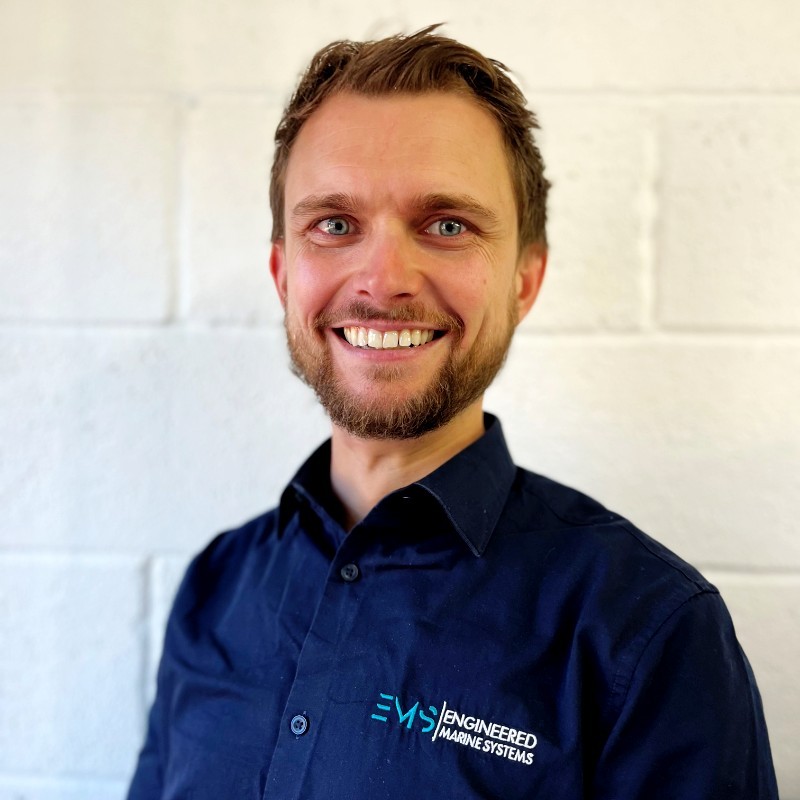Danielle met with Ben Pym to find out what the story is behind new-start, south coast business ‘EMS’;
Can you tell us about Engineered Marine Systems?
Engineered Marine Systems (EMS) is based in Southampton, UK. We specialise in marine systems design, working with naval architects, shipyards, OEMs, owners, and operators. Our business offering is split to three areas. We do vessel wide systems design in 2D and 3D. Covering mechanical,
electrical, domestic, and hydraulic disciplines with Class compliance, production detail and Bill of Materials for shipyard installation. We also design and manufacture a range of mechanical products, such as actuating platforms, doors, anchor systems in both the leisure and commercial sector. And
we’re a Palfinger Marine Crane dealer in the UK supporting operators in technical sales, service, and maintenance.
What is your role within the Company?
I founded EMS in 2017 and have continued as Managing Director of the company. A lot of my time is taken up with running the company and overseeing the various projects we have in progress at any given time. But I still get to do some design work – which is great because that is what I enjoy.
What is your career background?
I’ve always been around boats, racing dinghies through the RYA squad system as a junior and youth and later racing and maintaining race yachts in my teens and through university. I studied Naval Architecture at Solent University, after which I worked as Systems Design Engineer for a company
who specialised in the design and installation of bespoke performance yacht systems for the grandprix end of the market. I was fortunate enough to be involved in some cutting-edge projects with enormously varied requirements, but it was all about one thing, performance. Making the boats
lighter, faster, stronger and more capable to give the edge on the racecourse. That ethos, although often in the commercial sector so slightly different, has remained in the delivery of our design and products for our customers today.
What excites you most about your job?
The people I get to work with. Our customers come to us because they want their vessel to be the best in the fleet. Whether it’s our Nav Arc clients, vessel operators or shipyards, they’ve made an active decision to invest in design as a result they typically get a superior product. We get to work
with the client direct to better understand their requirements and work with them to deliver a complete solution. It’s been fantastic sharing the 3D systems model with operators for example, some of whom have not seen this maturity in design, and who can see exactly where equipment is
positioned in engine rooms, tech spaces, around walkways to ensure they have clear access and good service space on their new vessel. It’s 21st century shipbuilding!
What are your hobbies outside of work?
I still sail as much as I can in our 1958 Firefly dinghy. I’m training for a marathon at the end of the year, and when not sailing or running I’m maintaining and driving (when it’s in one piece) my 1957 Austin A35.
What has Engineered Marine Systems achieved so far?
We’ve achieved a strong business growth since 2017 and continued to invest and develop our design team. Looking forward and we’re keen to support more customers across the commercial marine sector. We achieved our ISO9001 LRQA Management System certification earlier this year in the
interest of improving our business processes. We took on the Palfinger dealership 2021 and have invested in training of our team to better support our customer base.
We’ve been involved in a number of forward-thinking projects across hybrid CTV’s, methanol projects, decarbonisation studies and defence demonstrator projects. We’ve also been fortunate enough support project further afield in the US and Asia workboat markets.
What are your goals for Engineered Marine Systems?
To continue to offer forward thinking, high-quality, elegant design solutions that fundamentally improve the user experience, operational efficiency, reduce build time, and contribute to long term more sustainable operation!
Why did you decide to become a member of The Workboat Association?
A large portion of our projects are in the workboat sector, so its natural fit. As a relatively young company we want to raise our profile and meet likeminded people in the industry. We also have a lot to offer technically on the journey of decarbonisation of the industry. Environmental
sustainability will be systems led, and we’re working on several projects bringing solutions to the marine sector which we look forward to sharing.
How do you feel The Workboat Association can benefit you?
We’ll look to attend as many WA events throughout the year as possible to meet others in the network and we’ll have the opportunity share our technical experience, contributing to the direction and improvements in the sector.

